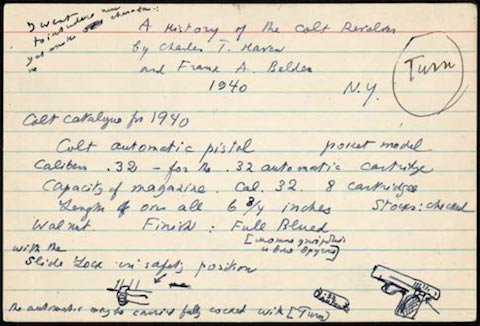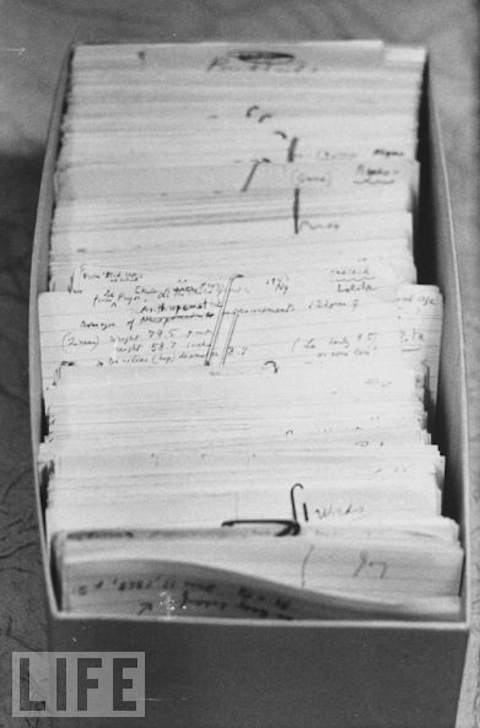Index card system to track daily, weekly, and monthly routines by [[Anna Havron]]
Brief outline of a tickler file system for today, daily, weekly, and monthly to do items.
Index card system to track daily, weekly, and monthly routines by [[Anna Havron]]
Brief outline of a tickler file system for today, daily, weekly, and monthly to do items.
It requires but a moment's reflection to perceivethat even the vertical files with the correspondence binders arebut an imitation of a set of cards, on a larger scale. The set ofcards can fairly be regarded as the basis of the entire system,hence it is properly called the card system.
He notes the general equivalency of cards and papers in vertical files.
One of the primary affordances that individual atomic cards have is the ability to more easily re-arrange and reuse them for various purposes in comparison with larger sheets with greater amounts of data on them.
Liebenson, Donald. “Classic Hollywood: Remembering Phyllis Diller (and 52,569 of Her Jokes) at the Smithsonian.” Los Angeles Times, May 12, 2017, sec. Television. https://www.latimes.com/entertainment/tv/la-ca-st-phyllis-diller-smithsonian-20170512-story.html.
Around 1956: "My next task was to prepare my course. Since none of the textbooks known to me was satisfactory, I resorted to the maieutic method that Plato had attributed to Socrates. My lectures consisted essentially in questions that I distributed beforehand to the students, and an abstract of the research that they had prompted. I wrote each question on a 6 × 8 card. I had adopted this procedure a few years earlier for my own work, so I did not start from scratch. Eventually I filled several hundreds of such cards, classed them by subject, and placed them in boxes. When a box filled up, it was time to write an article or a book chapter. The boxes complemented my hanging-files cabinet, containing sketches of papers, some of them aborted, as well as some letters." (p. 129)
This sounds somewhat similar to Mark Robertson's method of "live Roaming" (using Roam Research during his history classes) as a teaching tool on top of other prior methods.
link to: Roland Barthes' card collection for teaching: https://hypothes.is/a/wELPGLhaEeywRnsyCfVmXQ
there might be a miscellaneous division, which wouldserve as a "tickler" and which might even be equipped with a set ofcalendar guides so that the "follow-up" system may be used.
An example of a ticker file in the vein of getting things done (GTD) documented using index cards and a card file from 1917. Sounds very familiar to the Pile of Index Cards (PoIC) from the early 2000s.
In "On Intellectual Craftsmanship" (1952), C. Wright Mills talks about his methods for note taking, thinking, and analysis in what he calls "sociological imagination". This is a sociologists' framing of their own research and analysis practice and thus bears a sociological related name. While he talks more about the thinking, outlining, and writing process rather than the mechanical portion of how he takes notes or what he uses, he's extending significantly on the ideas and methods that Sönke Ahrens describes in How to Take Smart Notes (2017), though obviously he's doing it 65 years earlier. It would seem obvious that the specific methods (using either files, note cards, notebooks, etc.) were a bit more commonplace for his time and context, so he spent more of his time on the finer and tougher portions of the note making and thinking processes which are often the more difficult parts once one is past the "easy" mechanics.
While Mills doesn't delineate the steps or materials of his method of note taking the way Beatrice Webb, Langlois & Seignobos, Johannes Erich Heyde, Antonin Sertillanges, or many others have done before or Umberto Eco, Robert Greene/Ryan Holiday, Sönke Ahrens, or Dan Allosso since, he does focus more on the softer portions of his thinking methods and their desired outcomes and provides personal examples of how it works and what his expected outcomes are. Much like Niklas Luhmann describes in Kommunikation mit Zettelkästen (VS Verlag für Sozialwissenschaften, 1981), Mills is focusing on the thinking processes and outcomes, but in a more accessible way and with some additional depth.
Because the paper is rather short, but specific in its ideas and methods, those who finish the broad strokes of Ahrens' book and methods and find themselves somewhat confused will more than profit from the discussion here in Mills. Those looking for a stronger "crash course" might find that the first seven chapters of Allosso along with this discussion in Mills is a straighter and shorter path.
While Mills doesn't delineate his specific method in terms of physical tools, he does broadly refer to "files" which can be thought of as a zettelkasten (slip box) or card index traditions. Scant evidence in the piece indicates that he's talking about physical file folders and sheets of paper rather than slips or index cards, but this is generally irrelevant to the broader process of thinking or writing. Once can easily replace the instances of the English word "file" with the German concept of zettelkasten and not be confused.
One will note that this paper was written as a manuscript in April 1952 and was later distributed for classroom use in 1955, meaning that some of these methods were being distributed from professor to students. The piece was later revised and included as an appendix to Mill's text The Sociological Imagination which was first published in 1959.
Because there aren't specifics about Mills' note structure indicated here, we can't determine if his system was like that of Niklas Luhmann, but given the historical record one could suppose that it was closer to the commonplace tradition using slips or sheets. One thing becomes more clear however that between the popularity of Webb's work and this (which was reprinted in 2000 with a 40th anniversary edition), these methods were widespread in the mid-twentieth century and specifically in the field of sociology.
Above and beyond most of these sorts of treatises on note taking method, Mills does spend more time on the thinking portions of the practice and delineates eleven different practices that one can focus on as they actively read/think and take notes as well as afterwards for creating content or writing.
My full notes on the article can be found at https://jonudell.info/h/facet/?user=chrisaldrich&max=100&exactTagSearch=true&expanded=true&addQuoteContext=true&url=urn%3Ax-pdf%3A0138200b4bfcde2757a137d61cd65cb8
I am trying, you see, to build aframework containing all the key elements which enterinto the work; then to put each section in separate fbldersand continually readjust the whole framework aroundchanges in them.
Evidence that Mills is talking specifically about papers and individual folders (potentially tagged or categorized) rather than a card index system.
But how is this f i l e - - w h i c h so far must seem to thereader more like a j o u r n a l - - u s e d in intellectual produc-tion?
By asking this question this way, Mills is explicitly indicating that his "file" is not a journal, and by implication probably doesn't take the form of a notebook, though we should be on the lookout for more evidence of this given the long tradition of the commonplace book.
Use of File
It bears pointing out that Mills hasn't specifically described the form of his "file". Is he using note cards, slips, sheets of paper? Ostensibly one might suppose given his context and the word "file" which he uses that he may be referring to either hanging files, folders, and sheets of paper, or a more traditional index card file.
Posted byu/jackbaty4 hours agoCard sizes .t3_xib133._2FCtq-QzlfuN-SwVMUZMM3 { --postTitle-VisitedLinkColor: #9b9b9b; --postTitleLink-VisitedLinkColor: #9b9b9b; --postBodyLink-VisitedLinkColor: #989898; } I've been on-again/off-again with paper for PKM, but one thing remains consistent each time: I don't enjoy using 4x6 index cards. I much prefer 3x5-inch cards. I realize that it's irrational, but there it is.My question is if I dive into building an antinet, will I regret using 3x5 cards? I already have hundreds of them. I have dividers, holders, and storage boxes for them. I just prefer how they _feel_, as weird as that sounds.I'd like to hear if people are using 3x5 cards successfully or if you've come to regret it.
While it may be slightly more difficult to find larger metal/wood cases for the 4x6 or 5x8 cards, it's a minor nuisance and anyone who wants them will eventually find the right thing for them. Beyond this, choose the card size that feels right to you.
If you don't have an idea of what you need or like, try things out for 10-20 cards and see how it works for you, your handwriting size, and general needs. People have been using 3x5, 4x6, and even larger for hundreds of years without complaining about any major issues. If Carl Linnaeus managed to be okay with 3x5, which he hand cut by the way, I suspect you'll manage too.
Of course I won't mention to the Americans the cleverness of the A6, A5, A4 paper standards which allows you to fold the larger sizes in half to get the exact next smaller size down. Then you might get the benefit of the smaller size as well as the larger which could be folded into your collection of smaller cards, you just have to watch out for accidentally wrapping ("taco-ing") a smaller card inside of a larger one and losing it. I suppose you could hand cut your own 5" x 6" larger cards to do this if you found that you occasionally needed them.
For the pocketbook conscious, 3x5 does have the benefit of lower cost as well as many more options and flexibility than larger sizes.
At least commercial card sizes are now largely standardized, so you don't have deal with changing sizes the way Roland Barthes did over his lifetime.
My personal experience and a long history of so many manuals on the topic saying "cards of the same size" indicates that you assuredly won't have fun mixing different sized slips together. I personally use 3x5" cards in a waste book sense, but my main/permanent collection is in 4x6" format. Sometimes I think I should have done 3 x 5, but it's more like jealousy than regret, particularly when it comes to the potential of a restored fine furniture card catalog. But then again...
When Vladimir Nabokov died in 1977, he left instructions for his heirs to burn the 138 handwritten index cards that made up the rough draft of his final and unfinished novel, The Original of Laura. But Nabokov’s wife, Vera, could not bear to destroy her husband’s last work, and when she died, the fate of the manuscript fell to her son. Dmitri Nabokov, now seventy-five—the Russian novelist’s only surviving heir, and translator of many of his books—has wrestled for three decades with the decision of whether to honor his father’s wish or preserve for posterity the last piece of writing of one of the greatest writers of the twentieth century.
Nabokov's wishes were that his heirs burn the index cards on which he had handwritten the beginning of his unfinished novel The Original of Laura. His wife Vera, not able to destroy her husband's work, couldn't do it, so the decision fell to their son Dimitri. Having translated many of his father's works previously, Dimitri Nabokov ultimately allowed Penguin the right to publish the unfinished novel.
Alternate index card holding furniture for display?<br /> https://www.reddit.com/r/antinet/comments/wffvs4/alternate_index_card_holding_furniture_for_display/
Separate from boxes for long term card holding storage, does anyone have any suggestions they like for organizing or temporarily displaying cards?
I've got a couple card tray rack organizers (originally intended for playing cards, but great for zettels) which I generally like.

I've also seen Levenger's note card "bleachers" which are similar, but more expensive. - Note Card Bleachers - Portable Note Card Bleachers - Nantucket Bamboo Compact Bleachers
 Levenger index card bleacher for compactly displaying index cards in an array on a desk so that portions are visible but that they don't take up space.
Levenger index card bleacher for compactly displaying index cards in an array on a desk so that portions are visible but that they don't take up space.
Does anyone have anything else they like for compact working/displaying aside from laying cards out on tables/desks?
Do you have other methods for this sort of organization or layout of ideas visually? Corkboards, magnetic whiteboards/walls, other?
Over the course of his intellectual life, from about 1943 until hissudden death in 1980, Barthes built a card index consisting of morethan 12,250 note cards – the full extent of this collection was notknown until access to it was granted to the manuscript researchers ofthe Institut Mémoires de l’édition contemporaine (IMEC) inFrance (Krapp, 2006: 363).3
Roland Barthes accumulated a card index of more than 12,250 note cards beginning in 1943 which were held after his death in 1980 at the Institut Mémoires de l’édition contemporaine (IMEC) in France.
Barthes' dates 12 November 1915 – 26 March 1980 age 64
He started his card index at roughly age 28 and at around the same time which he began producing written work. (Did he have any significant writing work or publications prior to this?)
His card collection spanned about 37 years and at 12,250 cards means that was producing on average 0.907 cards per day. If we don't include weekends, then he produced 1.27 cards per day on average. Compare this with Ahrens' estimate of 6 cards a day for Niklas Luhmann.
With this note I'm starting the use of a subject heading (in English) of "card index" as a generic collection of notes which are often kept in one or more boxes. This is to distinguish it from the more modern idea of zettelkasten in the Luhmann framing which also connotes a dense set of links between the cards themselves, though this may not have been the case historically. Card index is also specifically separate from 'index card' which is an individual instance of an item that might be found in a card index. At present, I'm unaware of a specific word in English which defines the broader note taking context or portions thereof relating to index cards in the same way that a zettelkasten implies. This may be the result of the broad use of index cards for so many varying uses in the early 20th century. For these other varying uses I'll try to differentiate them henceforth with the generic 'index card files' which might also be used to describe the containers in which cards might be found.
It is also the best support for the opera aperta, whose desire was pervasive in the1950s and 1960s
Denis Hollier suggests that the index card file is "the best support for the opera aperta, whose desire was pervasive in the 1950s and 1960s."
Wilken, Rowan. “The Card Index as Creativity Machine.” Culture Machine 11 (2010): 7–30.
file: https://culturemachine.net/wp-content/uploads/2019/01/373-604-1-PB.pdf
I am speaking here of what appear to be Barthes’ fichier boîte or indexcard boxes which are visible on the shelf above and behind his head.
First time I've run across the French term fichier boîte (literally 'file box') for index card boxes or files.
As someone looking into note taking practices and aware of the idea of the zettelkasten, the suspense is building for me. I'm hoping this paper will have the payoff I'm looking for: a description of Roland Barthes' note taking methods!
https://www.openculture.com/2014/02/the-notecards-on-which-vladimir-nabokov-wrote-lolita.html
Some basic information about Vladimir Nabokov's card file which he was using to write The Origin of Laura and a tangent on cards relating to Lolita.



An alternate view of Roland Barthes, likely taken in his 1963 session with Henri Cartier-Bresson. Index card boxes can be seen on the shelf behind him.
Henri Cartier-Bresson, Roland Barthes, 1963. © PAR79520 Henri CartierBresson/Magnum Photos.
A photo of Roland Barthes from 1963 featured in Picturing Barthes: The Photographic Construction of Authorship (Oxford University Press, 2020) DOI: 10.5871/bacad/9780197266670.003.0007
There appears to be in index card file behind him in the photo, which he may have used for note taking in the mode of a zettelkasten.

link to journal article notes on:
Wilken, Rowan. “The Card Index as Creativity Machine.” Culture Machine 11 (2010): 7–30. https://culturemachine.net/creative-media/